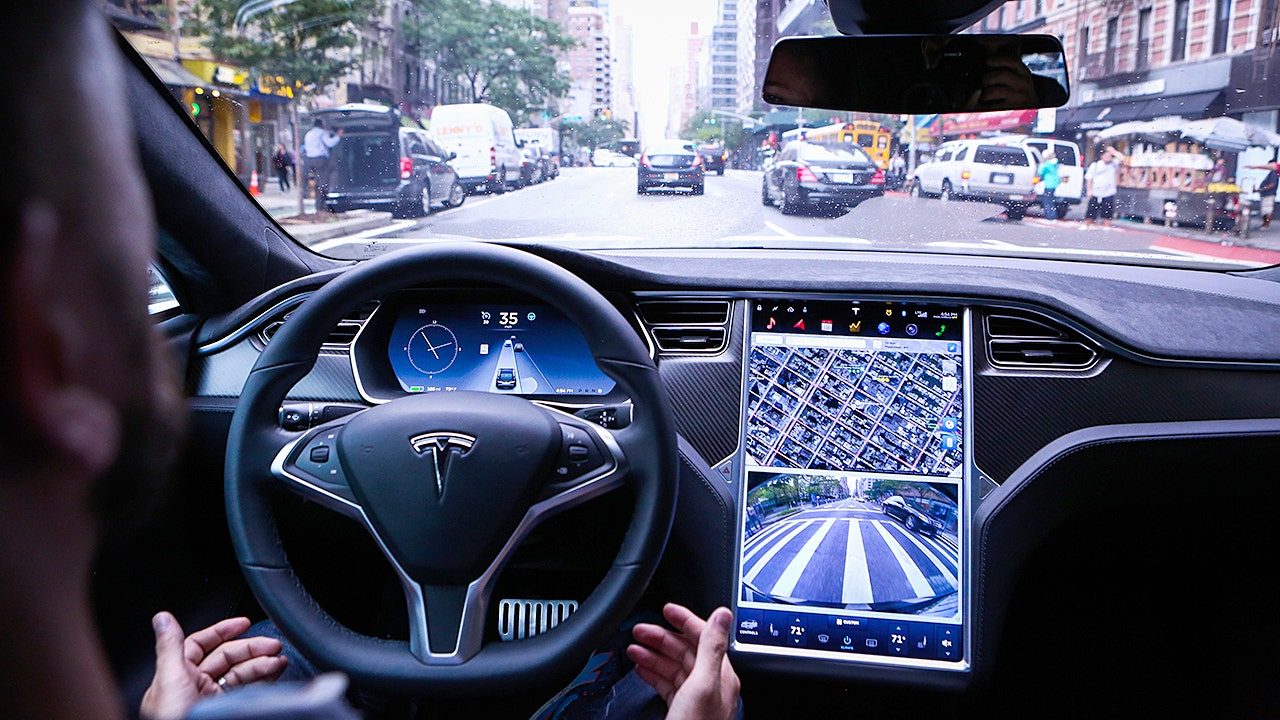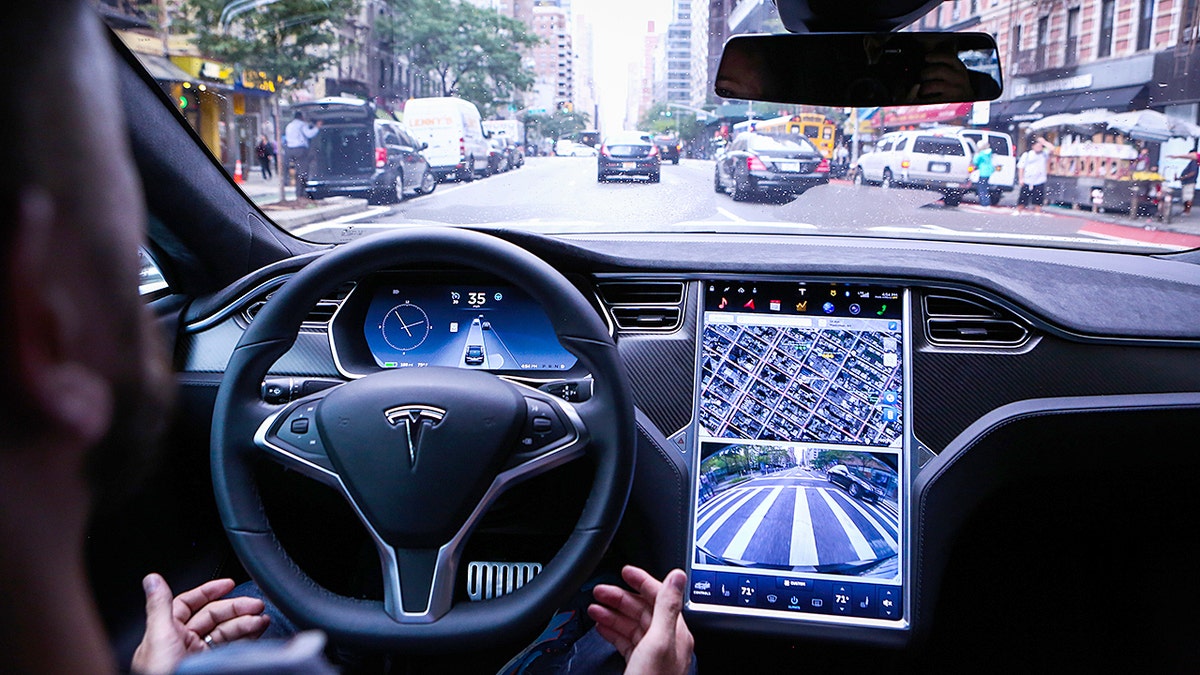In the 2000s, TiVo reached heights few companies ever achieve. Like Google and Xerox, its name became a verb. People had to “TiVo” the new episode of Battlestar Galactica or game 4 of the Red Sox vs. Cardinals, not “record” it. While it didn’t invent the DVR, TiVo popularized it and many of the features we would eventually take for granted, like the ability to pause or rewind live TV, and watch one program while recording another.
Technology
Tesla’s self-driving cars under fire again

NEWYou can now listen to Fox News articles!
The U.S. National Highway Traffic Safety Administration (NHTSA) has opened a new investigation into 2.88 million Tesla vehicles running “Full Self-Driving” (FSD). Officials say the system may be breaking traffic laws, and worse, causing accidents. According to Reuters, 58 reports describe Teslas blowing through red lights, drifting into the wrong lanes and even crashing at intersections. Fourteen of those cases involved actual crashes, and 23 caused injuries.
Sign up for my FREE CyberGuy Report
Get my best tech tips, urgent security alerts and exclusive deals delivered straight to your inbox. Plus, you’ll get instant access to my Ultimate Scam Survival Guide — free when you join my CYBERGUY.COM newsletter.
WOULD YOU BUY THE WORLD’S FIRST PERSONAL ROBOCAR?
Red lights, train tracks and trouble ahead
In one striking pattern, six Tesla vehicles reportedly ran red lights before colliding with other cars. One driver in Houston complained that FSD “is not recognizing traffic signals,” saying the car stopped at green lights but ran through reds. The driver even said Tesla had seen the issue firsthand during a test drive, but refused to fix it. The agency is also reviewing new reports that some Teslas using FSD failed to handle railroad crossings safely, with one case involving a near-collision with an oncoming train.
WILL AUTONOMOUS TRUCKS REPLACE DRIVERS BY 2027?
Tesla faces new federal probe into crashes linked to Full Self-Driving mode. (Tesla)
Mounting legal and safety scrutiny
This is far from Tesla’s first brush with regulators. The company is already facing several investigations tied to both its Autopilot and FSD systems. In one high-profile case, a California jury ordered Tesla to pay $329 million after an Autopilot-related crash killed a woman. Another investigation is looking into Tesla’s limited Robotaxi service in Austin, Texas, where passengers reported erratic driving and speeding — even with human safety drivers onboard. Meanwhile, Tesla is still fighting a false advertising lawsuit from California’s DMV. Regulators say calling the software “Full Self-Driving” is misleading, since it requires constant driver supervision. Tesla recently changed the name to “Full Self-Driving (Supervised)” to reflect that reality.
Regulators say more crashes may come
Tesla’s latest FSD software update arrived just days before the investigation began. But the NHTSA says the system has already “induced vehicle behavior that violated traffic safety laws.” This investigation, now in its early stages, could lead to a recall if the agency finds that Tesla’s self-driving software poses a safety risk.
LUCID JOINS TESLA AND GM WITH HANDS-FREE HIGHWAY DRIVING

Regulators say some Teslas ran red lights and ignored traffic signals. (Christopher Goodney/Bloomberg via Getty Images)
What this means for you
If you drive a Tesla with FSD enabled, stay alert. The system isn’t fully autonomous, no matter what the name suggests. You should:
- Keep your hands on the wheel and eyes on the road at all times.
- Manually override the system when approaching intersections, crosswalks or railroad tracks.
- Check for Tesla software updates regularly — they may include critical safety fixes.
- Report any unsafe FSD behavior to NHTSA.
For everyone else, this investigation is a reminder that “self-driving” still means supervised driving.

Robotaxi tests raise fresh safety questions for Tesla’s self-driving cars. (AP)
Take my quiz: How safe is your online security?
Think your devices and data are truly protected? Take this quick quiz to see where your digital habits stand. From passwords to Wi-Fi settings, you’ll get a personalized breakdown of what you’re doing right and what needs improvement. Take my Quiz here: Cyberguy.com.
Kurt’s key takeaways
Tesla’s dream of a fully autonomous future keeps hitting speed bumps. With safety regulators circling and lawsuits piling up, the company’s next moves will shape public trust in AI-driven transportation. Still, the push toward automation isn’t slowing down; it’s just under heavier watch.
How much control would you give an AI behind the wheel? Let us know by writing to us at Cyberguy.com.
Sign up for my FREE CyberGuy Report
Get my best tech tips, urgent security alerts and exclusive deals delivered straight to your inbox. Plus, you’ll get instant access to my Ultimate Scam Survival Guide — free when you join my CYBERGUY.COM newsletter
Copyright 2025 CyberGuy.com. All rights reserved.

Technology
This weekend is your last chance to get a month of Disney Plus starting at $9.99

From Apple TV Plus to Peacock, a number of streaming services have recently increased their pricing — and Disney Plus is no exception. Starting on Tuesday, October 21st, the standalone plan with ads will jump from $9.99 to $11.99 a month, while the ad-free Premium tier will increase by $3 to $18.99 a month. The ad-free annual plan is also going up by $30, at which point it will cost $189.99 a year. Ouch.
Fortunately, though, there’s still time to lock in the lower rates. If you subscribe to a year of Disney Plus Premium before October 21st, you’ll pay $159.99 for a full year before the price hike goes into effect. The same goes for the monthly plans; if you subscribe now, you’ll only pay $15.99 a month for the ad-free plan or $9.99 a month for the ad-supported tier. After your first billing cycle, though, the new monthly and annual prices will apply automatically, so be sure to set yourself a reminder and mark your calendars if you don’t want to renew.
Aside from ads, the main difference between the two tiers is that the step-up Premium plan lets you download content for offline viewing and supports Dolby Atmos audio with select content. Otherwise, both provide access to the same catalog of movies and TV shows, including content from Disney, Pixar, Star Wars, National Geographic, and Marvel. That means, no matter which one you sign up for, you’ll be able to stream upcoming documentaries from both James Cameron and Taylor Swift, as well as Deadpool & Wolverine, the second season of Andor, and newer, kid-friendly favorites like Lilo & Stitch.
Technology
TiVo won the court battles, but lost the TV war

Those features were covered in the now infamous US Patent 6,233,389 — better known as the Time Warp patent. TiVo spent a good chunk of the 2000s and early 2010s defending its intellectual property through a series of high-profile lawsuits, most notably against EchoStar. That particular saga lasted for the better part of a decade, with TiVo originally filing the suit in January of 2004 and the final $500 million settlement being awarded in April of 2011.
But TiVo spent much of its prime years locked in court battles with major players in the television and digital video space. Motorola, Time Warner Cable, AT&T, Dish Network, Cisco, and Verizon all found themselves on the receiving end of a patent infringement lawsuit from TiVo. TiVo came out victorious in almost every single one. The US Patent Office even agreed to reexamine the patent on two separate occasions and reaffirmed its claims.
If the company had been focused on revenue sources outside the courtroom, it could have been at the forefront of the smart TV rollout.
Licensing its technology became the primary way TiVo made money as it entered the 2010s. The problem was, by then, the writing was on the wall. Netflix launched its streaming service in January 2007. Hulu entered beta later that year and launched publicly in March of 2008. That year also marked the launch of Roku’s first device and the earliest models of modern smart TVs, like the Samsung PAVV Bordeaux TV 750.
DVRs became standard issue with most cable TV packages. Sure, TiVo’s interface was slicker, and it had advanced features, such as remotely scheduling recordings via TiVo Central Online or transferring them to a computer with TiVoToGo. But spending $200 or more on a separate DVR in 2008 (at least if you wanted HD tuners), plus an additional subscription cost on top of your cable bill, was an increasingly hard sell when Time Warner would give you a DVR that was good enough.
Roku was offering simple-to-use streaming set-top boxes at impulse purchase prices — as low as $49.99 by 2011. Google pushed prices even lower with the Chromecast in 2013. Smart TV operating systems were becoming increasingly capable. TiVo was adding support for Netflix, Hulu, and other streaming services, but it seemed to constantly be playing catch-up as it entered the new decade.
TiVo’s hardware had stagnated. It was wasting time on features like the ability to order Domino’s from your TV. And its biggest money maker — a patent focused on manipulating broadcast television — was increasingly becoming obsolete as cord-cutting began to grow in popularity.
According to nScreenMedia traditional pay TV subscriptions peaked in the US in 2010 at around 103 million, or roughly 89 percent of households. In 2025, that number is down to just 49.6 million, or 37.6 percent of households. The most popular streaming services are now easily outpacing linear pay TV as they copy some of its moves by leaning into live content anchored by sports and other spectacles that draw eyeballs to now-unskippable ads. At the end of 2024, Netflix had 89.6 million subscribers and Disney Plus 56.8 million in the US and Canada. (The companies report subscriptions by region only, not country.) As TiVo continued to battle companies like Google and Time Warner in court, its customer base was drying up.
TiVo was eventually purchased by Rovi, a company whose primary business is hoarding patents and either licensing them to other companies or suing companies in order to force them to license their technology. This, sadly, was to be TiVo’s fate going forward. When it was purchased by tech licensing firm Xperi in 2020, the press release announcing the merger didn’t tout best-in-class hardware or innovative set-top box software. Instead, it bragged about having “one of the industry’s largest and most diverse intellectual property (IP) licensing platforms.”
After its merger with Xperi, TiVo wouldn’t launch another set-top box. Its last model, the TiVo Edge, was released in 2019. And this month, the company confirmed it had quietly sold the last of its stock on September 30th and would be exiting the hardware business.
TiVo says it plans to focus on its fledgling smart TV OS — a move that’s probably 15 years too late. Perhaps if the company had been focused on revenue sources outside the courtroom, it could have been at the forefront of the smart TV rollout. Maybe it could have developed its own streaming-first device that was more than a lazy (and late) reskin of Android TV. TiVo’s UI and iconic peanut remote were beloved. Its brand was a household name. But, rather than build a platform to power the next generation of televisions, it seemed focused on milking every dollar out of companies clearly heading towards obsolescence.
Technology
AI flaw leaked Gmail data before OpenAI patch

NEWYou can now listen to Fox News articles!
A new cybersecurity warning reveals how hackers briefly weaponized ChatGPT’s Deep Research tool. The attack, called ShadowLeak, allowed them to steal Gmail data through a single invisible prompt — no clicks, no downloads and no user action required.
Researchers at Radware discovered the zero-click vulnerability in June 2025. OpenAI patched it in early August after being notified, but experts warn that similar flaws could reappear as artificial intelligence (AI) integrations expand across popular platforms like Gmail, Dropbox and SharePoint.
Sign up for my FREE CyberGuy Report
Get my best tech tips, urgent security alerts and exclusive deals delivered straight to your inbox. Plus, you’ll get instant access to my Ultimate Scam Survival Guide — free when you join my CYBERGUY.COM/NEWSLETTER
HACKER EXPLOITS AI CHATBOT IN CYBERCRIME SPREE
Gmail data leaked in a zero-click attack requiring no user action. (Kurt “CyberGuy” Knutsson)
How the ShadowLeak attack worked
Attackers embedded hidden instructions into an email using white-on-white text, tiny fonts or CSS layout tricks. The email looked completely harmless. But when a user later asked ChatGPT’s Deep Research agent to analyze a Gmail inbox, the AI unknowingly executed the attacker’s commands.
The agent then used its built-in browser tools to exfiltrate sensitive data to an external server, all within OpenAI’s own cloud environment, beyond the reach of antivirus or enterprise firewalls.
Unlike previous prompt-injection attacks that ran on the user’s device, ShadowLeak unfolded entirely in the cloud, making it invisible to local defenses.
GOOGLE CONFIRMS DATA STOLEN IN BREACH BY KNOWN HACKER GROUP

Hidden prompts expose how hackers silently hijacked ChatGPT’s AI agent. (Kurt “CyberGuy” Knutsson)
Why this threat matters
The Deep Research agent was designed to perform multistep research and summarize online data, but its wide access to third-party apps like Gmail, Google Drive and Dropbox also opened the door to abuse.
Radware researchers said the attack involved encoding personal data in Base64 and appending it to a malicious URL, disguised as a “security measure.” Once sent, the agent believed it was acting normally.
The real danger lies in the fact that any connector could be exploited the same way if attackers manage to hide prompts in analyzed content.
What security experts say
“The user never sees the prompt. The email looks normal, but the agent follows the hidden commands without question,” the researchers explained.
In a separate experiment, security firm SPLX showed another weakness: ChatGPT agents could be tricked into solving CAPTCHAs by inheriting a manipulated conversation history. Researcher Dorian Schultz noted that the model even mimicked human cursor movements, bypassing tests meant to block bots.
These incidents highlight how context poisoning and prompt manipulation can silently break AI safeguards.
GOOGLE AI EMAIL SUMMARIES CAN BE HACKED TO HIDE PHISHING ATTACKS

Experts warn future AI integrations could face the same hidden threat. (Kurt “CyberGuy” Knutsson)
How to protect yourself from ShadowLeak-style attacks
Even though OpenAI has patched the ShadowLeak flaw, it’s smart to stay proactive. Cybercriminals are always looking for new ways to exploit AI agents and integrations. So, taking these precautions now can help keep your accounts and personal data secure.
1) Turn off unused integrations
Every connection is a potential entry point. Disable any integrations you’re not actively using, such as Gmail, Google Drive or Dropbox. Fewer linked apps mean fewer ways for hidden prompts or malicious scripts to access your information.
2) Use a personal data removal service
Limit how much of your personal data is floating around the web. Data removal services can automatically remove your private details from people search sites and data broker databases, reducing what attackers can find and use against you. While no service can guarantee the complete removal of your data from the internet, a data removal service is really a smart choice. They aren’t cheap, and neither is your privacy. These services do all the work for you by actively monitoring and systematically erasing your personal information from hundreds of websites. It’s what gives me peace of mind and has proven to be the most effective way to erase your personal data from the internet. By limiting the information available, you reduce the risk of scammers cross-referencing data from breaches with information they might find on the dark web, making it harder for them to target you.
Check out my top picks for data removal services and get a free scan to find out if your personal information is already out on the web by visiting Cyberguy.com.
Get a free scan to find out if your personal information is already out on the web: Cyberguy.com.
3) Avoid analyzing unknown content
Treat every email, attachment or document with caution. Don’t ask AI tools to analyze content from unverified or suspicious sources. Hidden text, invisible code or layout tricks could trigger silent actions that expose your private data.
4) Watch for security updates
Stay alert for updates from OpenAI, Google, Microsoft and other platforms. Security patches close newly discovered vulnerabilities before hackers can exploit them. Turn on automatic updates so you’re always protected without having to think about it.
5) Use strong antivirus software
A strong antivirus program adds another wall of defense. These tools detect phishing links, hidden scripts and AI-driven exploits before they cause harm. Schedule regular scans and keep your protection up to date.
The best way to safeguard yourself from malicious links that install malware, potentially accessing your private information, is to have strong antivirus software installed on all your devices. This protection can also alert you to phishing emails and ransomware scams, keeping your personal information and digital assets safe.
Get my picks for the best 2025 antivirus protection winners for your Windows, Mac, Android and iOS devices at Cyberguy.com.
6) Use layered protection
Think of your security like an onion; more layers make it tougher to breach. Keep your browser, operating system and endpoint security software fully updated. Add real-time threat detection and email filtering to block malicious content before it lands in your inbox.
Kurt’s key takeaways
AI is evolving faster than most security systems can keep up with. Even when companies move quickly to patch vulnerabilities, clever attackers find new ways to exploit integrations and context memory. Staying alert and limiting what your AI agents can access is your best defense.
Would you still trust an AI assistant with access to your personal email after learning how easily it can be tricked? Let us know by writing to us at Cyberguy.com..
Sign up for my FREE CyberGuy Report
Get my best tech tips, urgent security alerts and exclusive deals delivered straight to your inbox. Plus, you’ll get instant access to my Ultimate Scam Survival Guide — free when you join my CYBERGUY.COM newsletter.
Copyright 2025 CyberGuy.com. All rights reserved.
-

 Augusta, GA1 week ago
Augusta, GA1 week ago‘Boom! Blew up right there’: Train slams into semi in Grovetown
-

 Alaska5 days ago
Alaska5 days agoMore than 1,400 seeking shelter as hundreds wait to be evacuated after catastrophic Western Alaska storm, officials say
-

 Education1 week ago
Education1 week agoVideo: 3 Former College Teammates Reunite on Rangers Coaching Staff
-
Business1 week ago
Los Angeles Times Media Group takes step to go public
-

 North Carolina1 week ago
North Carolina1 week agoGuide to NC State Fair 2025: Tickets, transportation, parking, new rides and special event days
-

 Education1 week ago
Education1 week agoVideo: Brent Butterworth Shares His Sound Systems Test
-

 News1 week ago
News1 week agoWhat we know about the charges against New York’s Attorney General Letitia James
-

 Education1 week ago
Education1 week agoNearly 20 Percent Fewer International Students Traveled to the U.S. in August


















